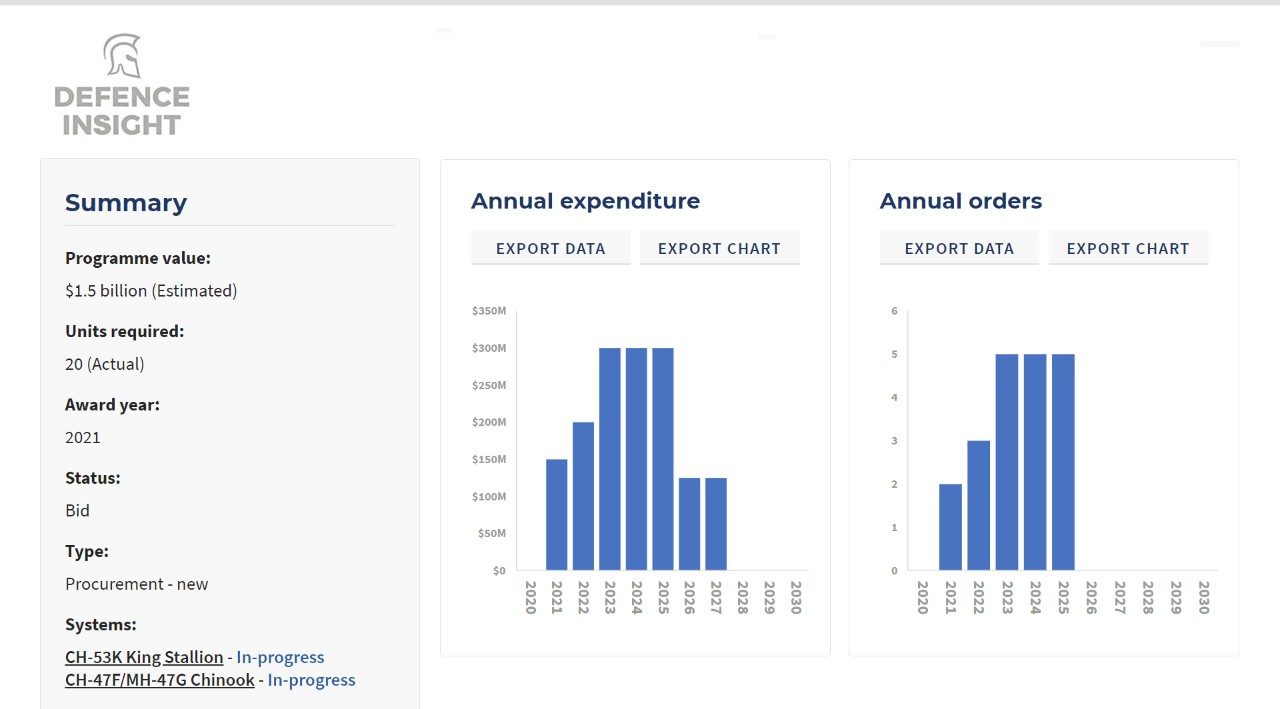The Israeli Air Force (IAF) is drawing closer to a decision on which platform will replace its fleet of 23 aging CH-53D Yas'ur helicopters (pictured) with 20-25 new heavy-lift platforms from 2025.
The two main options on the programme, estimated by Shephard Defence Insight to cost about $1.5 billion, are the Sikorsky CH-53K King Stallion and a hybrid of the Boeing CH-47F/MH-47G Chinook designed with longrange fuel tanks and an air-to-air refuelling probe.
The IAF overhauled its Yas'ur fleet in the 1980s and it is now upgrading these helicopters to the Yasur 2025 configuration, which includes new EW equipment, communications and obstacle-avoidance systems.
However, Israeli military planners want a quick decision (ideally by the end of 2020) on the new platform to replace the elderly CH-53. Pressure for new helicopters is especially intense from the IDF Depth Command, which runs SF missions beyond the borders of Israel.
IAF pilots have already tested the King Stallion and Chinook in the US before submitting full reports for evaluation in Israel.
In a 19 August video briefing attended by Shephard, Dan Schultz, president and CEO of Lockheed Martin company Sikorsky, said that CH-53K production is ‘ahead of schedule and under cost’. The helicopter is expected to reach IOC with the USMC in 2021.
Schultz argued that the marinised King Stallion has the same footprint as the CH-53D and it therefore requires no new infrastructure in Israel.
‘This is a smart aircraft with sensors built in. Following our commercial helicopter sustainment model, the aircraft can analyse itself,’ he said. ‘Israel has a stark choice: they can go with an aircraft that competed with the CH-53D already, or they can look into the future with the CH-53K.’

Steve McCulley, chief experimental test pilot at Sikorsky, said the downwash from the rotors on the King Stallion ‘will not affect other aircraft nearby. And thanks to the 21st century flight control systems, pilots have full authority to operate the aircraft amid downwash without getting blown away’.
He described how the CH-53K makes use of AI and predictive analytics, reducing the pilot workload and cutting maintenance costs. McCulley said that an engine change for the CH-53K takes about half a day, versus a full eight hours in the CH-53D or CH-53K.
‘All high-maintenance items have been removed from the CH-53K, which makes the work much easier for maintainers,’ he added.
Schultz highlighted successful air-to-air refuelling of the King Stallion using a drogue. McCulley acknowledged that this was no easy task ‘but on the first time out with the CH-53K, we hit [the] basket all three times during the air-to-air test. This is a testament to the stability of the CH-53K and the fly-by-wire flight control system, which is a vast improvement over the legacy system with its limited authority’.
Israeli military sources have indicated that the Chinook version being offered to the IAF is a hybrid between the CH47F and MH-47G SF heavy-lift variant, but with larger fuel tanks that resemble those on the Canadian CH-147F. The cockpit of the helicopter is expected to be fully computerised with unique systems for Israel.
Shephard Defence Insight notes that Israel will expect a significant level of industrial participation, which is likely to involve set-up costs and stage-payments well in advance of the first delivery. In this context, it may be significant that Sikorsky does not outsource of any CH-53K critical components, including gearboxes and blades.
Israeli military sources told Shephard the unit cost and life cycle cost of the two competitors will have a ‘major impact on the selection’. The CH-53K costs a little over $125 million per unit according to the FY2021 US defence budget, whereas the CH-47F is less than a third of this.
While the King Stallion and Chinook seem to be the front-runners at this stage, Bell-Boeing is still pushing for an IAF order of the V-22 Osprey, although political uncertainty and budget issues have cast doubt on the feasibility of such a plan. V-22 export customers are being advised to place an order before a September 2020 deadline to guarantee being part of US DoD multiyear contract pricing and production arrangements.




